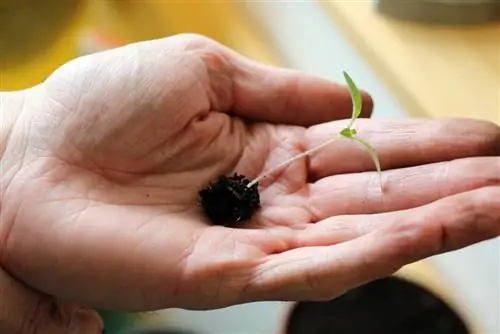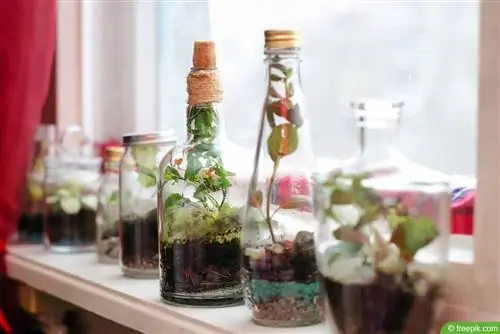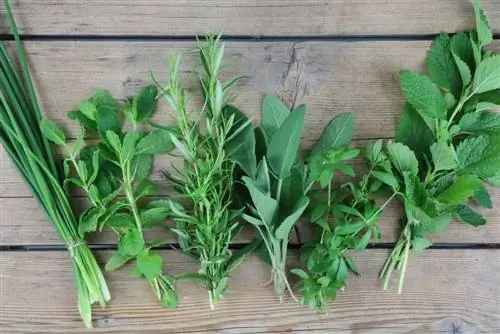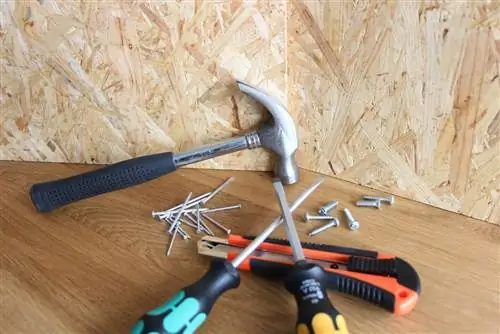- Author admin [email protected].
- Public 2023-12-17 03:39.
- Last modified 2025-06-01 06:48.
Many gardening enthusiasts no longer want to buy young plants for tomatoes, cucumbers or lettuce at the garden center, but instead want to grow their vegetables themselves from seeds. With an indoor greenhouse, vegetable plants can be grown on the windowsill before you go out into nature or a large greenhouse.
Advantages of DIY mini greenhouse
Many vegetables need a lot of light and heat to develop from a seed into a small plant. Greenhouses often provide these required conditions and with a small greenhouse on the windowsill you have a protected area for tomatoes, cucumbers etc. Always in sight.
- can be adapted to the required requirements
- made quickly
- interesting upcycling project
- Garbage can be creatively repurposed
- hardly any material costs
- is light and mobile
- growing up protected from the wind
- good supply of light
After pricking out and before hardening, tomatoes must first develop and grow well. With a small greenhouse you can always watch the plants grow on the windowsill in the children's room, the kitchen or at work.
You can also make friends, family and acquaintances happy as a small gift. From cress and vegetables to flowers and succulents, almost all plants can be grown in an indoor greenhouse, at least for a certain period of time.
What do you have to consider with a mini greenhouse?
- UV-impermeable PE film is best, so the plants receive enough light and are protected from wind and rain (if I put my small greenhouse on the balcony). That's why cling film is often used for small projects like this.
- When filling a small greenhouse, you also have to make sure that there is no waterlogging. So a drainage layer made of small stones under the potting soil is also advisable here - at least if the excess irrigation water cannot drain away any other way.
- A greenhouse for the windowsill must also be ventilated regularly, otherwise condensation is a very suitable trigger for mold formation.
Instructions for the mini greenhouse
It's best to take a look at all of our instructions for an indoor greenhouse beforehand and then choose the one that's right for you.
- How much space do I have available?
- How big does my mini greenhouse have to be for the plant to thrive?
- What materials are available to me?
- What do I trust in craftsmanship?
Note:
In all instructions you will only find the materials for building the greenhouse. Since different plants require different soil, planting etc. will be covered in detail in other articles by us.
Egg packaging
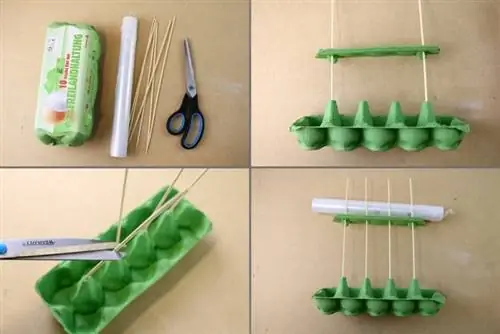
You need:
- Egg packaging (at least for 4 eggs)
- Wooden shish kebab skewers
- Cling film
- mandatory: plasticine / modeling clay / polymer clay or similar
- Scissors
Step 1
First, cut off the lid and the closure (be sure to keep it!) of the packaging.
Step 2
Put the wooden skewers through the egg carton from below, in the cross between the individual egg wells. Push the skewers through until they are flush with the bottom.
Tip:
You can fix the shish kebab skewer in the egg packaging with a little dough. This stabilizes the skewers and prevents them from slipping out.
Step 3
Now place the reserved locking tab onto the skewers from above. The cardboard serves as the “roof prince” and thus marks the highest point of your indoor greenhouse. You can use a small ball of modeling clay underneath the cardboard (around the skewer) to protect the top from slipping.
Step 4
Wrap the cling film, starting at the bottom, once around the egg carton - up over the prince - back down to the other side.
Tip:
With clothespins you can easily fix the film in a few places and then open it again for airing and watering.
Food packaging - bowl
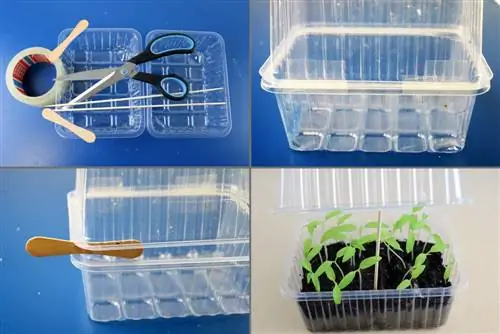
You need
- 2 Plastic food packaging - trays (e.g. for mushrooms)
- Adhesive tape or parcel tape, preferably transparent
- Wooden ice cream stick or wooden skewer
- Scissors or cutter
Step 1
Place both bowls next to each other and place a strip of tape over the touching edges.
Step 2
Close the resulting box and place another strip of adhesive tape on the back; these serve to stabilize it.
Step 3
In order to be able to ventilate your small greenhouse well, we recommend cutting a small wooden stick to the appropriate size. Either use an ice cream stick or a wooden shish kebab stick shortened to the appropriate length.
Tip:
If you only have one bowl available, you can also cover it with cling film - as a roof. The film can be easily attached to the edge with a few clothespins. To prevent the greenhouse from sweating, holes should be poked in the film and ventilated regularly.
PET bottle
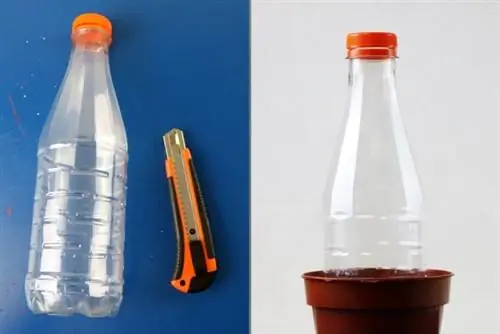
You need
- empty and cleaned PET bottle without label
- Scissors or craft knife
Step 1
Carefully cut off the bottom of the plastic bottle and degrade the edge so that no sharp corners or edges remain as a source of danger.
Step 2
Place the bottle in the soil over the plant to be protected.
Tip:
Make a few small holes in the lid so that the plant doesn't sweat too much in the greenhouse.
CD cases
You can easily and quickly make very sturdy mini greenhouses from old transparent CD cases. We use “normal” CD cases for our instructions, not slim cases or double CD cases.
Variant A
For the simplest version you only need 2 CD cases and some tape.
Step 1
Carefully remove the (usually black) CD holder from the Wednesday.
Step 2
Place the two cases (open at a 90 degree angle) together so that they form a square. You can fix the corners either with adhesive tape or with hot glue or superglue.
Step 3
You can either use another transparent CD case half as a roof - this would then have to be attached with an “adhesive tape hinge” like a greenhouse made from food packaging. Or you can simply use some cling film with a few air holes as a roof for your little DIY greenhouse.
Variant B
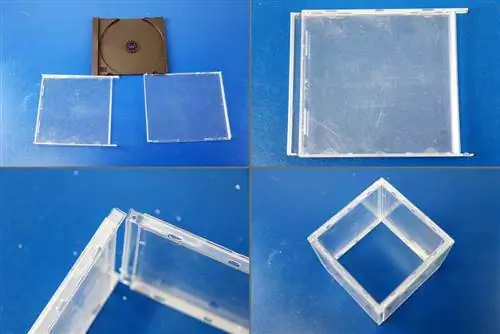
This version of a CD greenhouse is a little more complex, but a lot more stable and, above all, infinitely extendable. Thanks to its stable construction, this mini greenhouse is also suitable for the balcony.
This requires at least 4 CD cases.
Step 1
Carefully (!) disassemble the CD case into its three components. Be careful not to break any parts and use only as little pressure and force as necessary.
Step 2
Put the middle part with the CD holder aside and use the two outer parts of the CD packaging. The front flap is simply rotated 180 degrees and placed back on top. This is done slightly offset. The flap should snap into place easily or then not be able to be moved much.
If the two clips protrude on one side, the case is in the right place.
Step 3
Once you have converted all (at least) 4 cases like this, you can now click the many components into each other. Make sure that the resulting openings face inwards.
This creates a stable square that is similar to double glazing. This makes this greenhouse very stable and can also store heat better.
Tip:
You can also make longer or wider greenhouses with these building blocks. If you build several modules, they can also be stacked on top of each other with a little glue. This means you can let the mini greenhouse grow with the plants.
Step 4
You can use cling film as a roof or, with a little more crafting effort, you can make a folding roof out of CD cases.
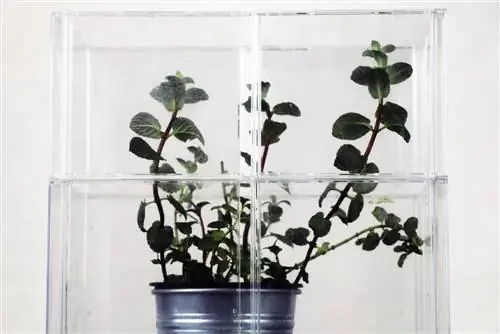
We hope that one of our instructions has convinced you and that you will also become a fan of “urban gardening”. Use a mini greenhouse either as a small alternative to the garden on the balcony or for growing tomatoes, cucumbers and lettuce on the windowsill.

